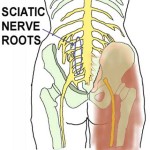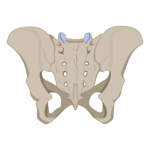 Sciatic nerve symptoms take on a number of forms.
Sciatic nerve symptoms take on a number of forms.
Sciatica isn’t a condition unto itself but a symptom of an injury to the sciatic nerve.
Piriformis syndrome, something we’ll talk about in other posts, is site specific.
It only happens at the location of the piriformis muscle and it only happens because that muscle is in spasm and pushing on the sciatic nerve.
Sciatica on the other hand can happen at any point along the lumbar spine where one of the nerve roots is exposed. Something—like a slipped disc— is pressing on the sciatic nerve sending pain down through the leg and sometimes all the way to the foot.
The sciatic nerve, also known as the ischiatic nerve, is the longest, widest nerve in the body.
It’s the yellow nerve in the illustration above. At its largest point, it’s as big around as an index finger.
Take a moment to look at your index finger. It’s pretty incredible to have a nerve this large moving through us. It deserves respect. The sciatic nerve provides most of the energy to the lower part of the body relaying signals from the brain to the legs.
Sciatic nerve symptoms always occur in the lower back where the nerve takes shape.
 The sciatic nerve is made up of five nerves that come out of the right and left-hand sides of the lower spine.
The sciatic nerve is made up of five nerves that come out of the right and left-hand sides of the lower spine.
You have a curve in your lower spine, and this area is referred to as the lumbar spine.
The lumbar spine includes five vertebrae (L1 – L5).
Below the lumbar spine is the sacrum.
The sacrum also consists of five vertebrae (S1 – S5).
However, these sacral vertebrae begin as unfused (like the rest of the spine), and then once we are standing and walking they fuse together making more of a plate.
 The nerves that make up the sciatic nerve come out of the bottom two lumbar vertebrae (L4 and L5 and the top three sacral vertebrae S1, S2, and S3).
The nerves that make up the sciatic nerve come out of the bottom two lumbar vertebrae (L4 and L5 and the top three sacral vertebrae S1, S2, and S3).
These five nerves come together out of L4, L5, S1, S2, and S3 to form two nerves, the tibial and the peroneal.
These two nerves eventually form one sheath and together make the sciatic nerve which runs through the pelvis passes in front of the piriformis and extends all the way down the back of the leg to the toes.
At the back of the knee those two nerves, the tibial and peroneal, divide again.
The peroneal nerve travels sideways (laterally) along the outside of the knee to the upper foot.
The tibial nerve continues to travel downward to the feet, and it innervates the heel and sole of the foot.
Sciatic nerve symptoms manifest in all sorts of pain from a mild ache to a sharp electric shock-like sensation running down your leg.
When the problem is particularly bad the pain radiates down to the foot resulting in eventual numbness. We will continue to explore the nature of sciatica and ways to alleviate its discomfort.
